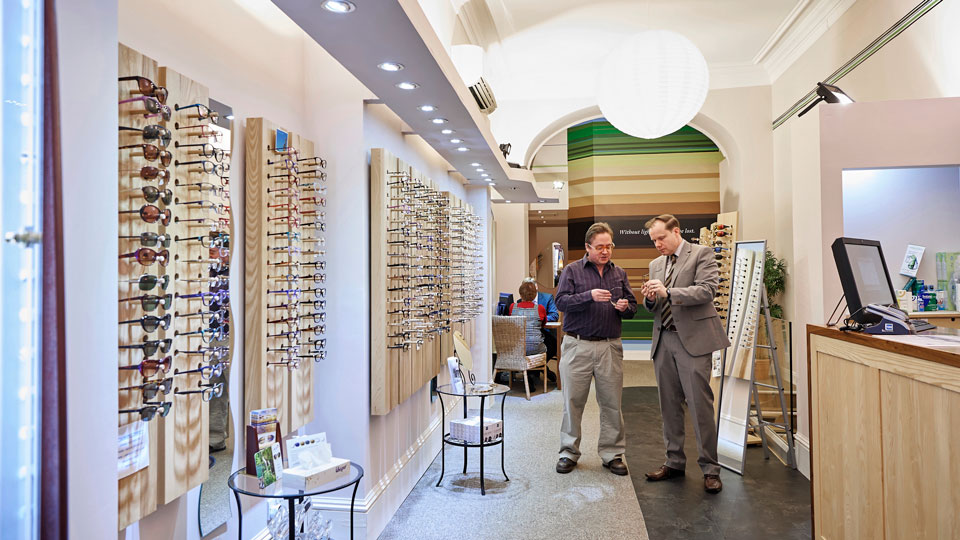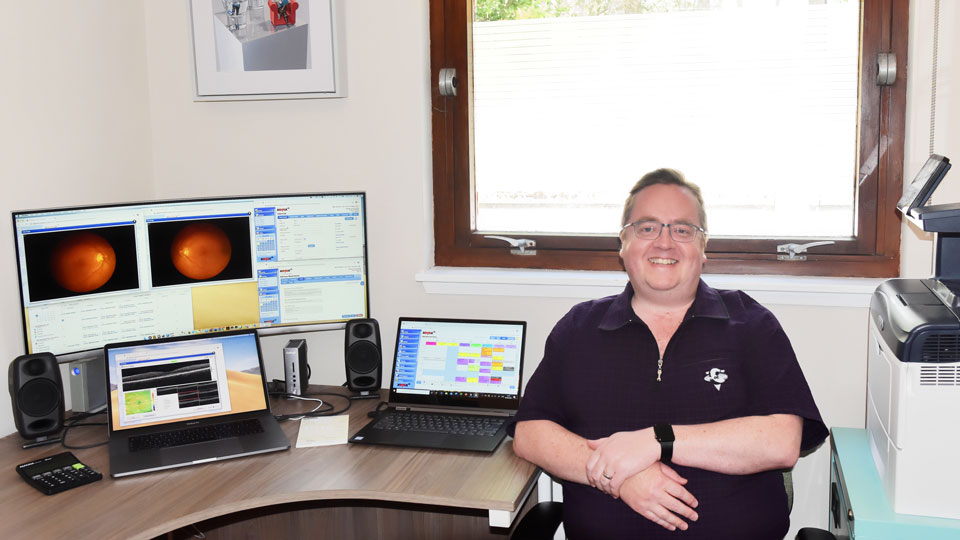- OT
- Life in practice
- Practitioner stories
- Coronavirus: on the ground in the Highlands
On the ground
Coronavirus: on the ground in the Highlands
Colin Pettinger on the value remote communities place on local businesses and thinking on his feet to treat a patient with marginal keratitis

17 June 2020
As the coronavirus (COVID-19) pandemic transforms the way optometrists practise, OT is sharing the experiences of optometrists across the UK. If you, or a colleague, is interested in sharing your story please get in touch by email.
In a nutshell
Location: Inverness, Golspie and Dingwall
Years qualified: 20
Mode of practice: independent optometrist.
I’m in the North Highlands of Scotland. We have three practices; one in the city of Inverness, another in the market town of Dingwall, and the final in a rural village called Golspie (population: 1350). Golspie is a two-and-a-half hour round trip from the nearest Emergency Eyecare Treatment Centre. That has been a real challenge. We have had a lot of calls from patients in that practice who do not want to face that journey just to get their eye looked at.
I have been qualified for 20 years and have jointly owned the practices for 10 years. The special thing about living and working in the Highlands is the wide-open spaces. Property prices are reasonable and crime rates are low. Working in a remote area, patients appreciate your presence more because you are the only practice for sometimes 40 or 50 miles in any direction.
For the patients who need to be referred, many will face big journeys to travel to secondary care. Even when patients have sight-threatening problems, some of these patients have never been to a hospital. It is difficult to get them to go. I have to explain to them that it is pretty serious, and they can get the condition treated but they need to go to the hospital.

Following the COVID-19 outbreak, both the Scottish Government and Optometry Scotland worked hard to get guidelines in place. As a small country, we were able to do that reasonably fast. We only had about two weeks of that madness, where no one knew what they were doing. One piece of advice would come out, only to be superseded two days later. Scotland acted quickly to stop all routine face-to-face eye examinations.
For us, it was a binary change. We were busy and then suddenly we weren’t seeing patients. It was a 70% to 80% drop in revenue, almost overnight. In a way that was positive because for both patients and the workforce it was the uncertainty that was causing a lot of the stress. Although the financial consequences were huge, they were the same for everybody.
In the remote and rural setting, there was very little awareness early on of the level of danger to both practitioners and patients. We had plenty of patients who were coming in as normal and wondering what the fuss was about. There are relatively few office jobs up here. There is no home working option for a lot of the rural professions.
I have an independent prescribing qualification and have been doing remote telemedicine ever since we stopped seeing patients. I am seeing about 20 patients remotely each week. Around 80 to 85% are managed within the practice and around 15% need referring to the Emergency Eyecare Treatment Centre.
I am using home visual acuity charts that I email to patients, Amsler grids, smartphone photographs and video. On one occasion I used a super telephoto camera to take a photograph of a patient’s eye from 10 feet away. She was an elderly lady with marginal keratitis who didn’t have a smart phone to take a photo with. She lived three doors down from the practice, so we got her to walk down the road and I took the photo from the other side of the glass.
One thing that has helped us quite a bit is having a pop-up online shop. Many online shopping platforms are doing 90-day free trials because of COVID-19. You can knock up a little pop up shop for your practice in an afternoon. That has helped us where a patient has phoned who has run out of eye drops and if we have them in stock they can come and pick them up in a few hours or have them posted out. That is bringing in a few extra pennies.
It’s not a huge volume of sales but patients appreciate that you are still engaging with them. They are so used to you being part of the community – a lot of people are missing that. We didn’t have an online shop before; we only had a basic website for contact details, and I am beginning to ask myself why we didn’t do it before.
On one occasion I used a super telephoto camera to take a photograph of a patient’s eye from 10 feet away
In some ways the break from the daily grind of a full diary has enabled us to think about other areas in which we can provide a better service to patients. We weren’t doing a huge amount of social media before COVID-19. It is only during the lockdown that we have realised how absolutely vital it is. We have had an increased amount of contact through social media that has made us rethink how we manage it within the business. We will have a rota for staff to manage the social media regularly. Again, that is something that we probably should have always been doing, but it is only now that we realise it.
It was a big transition from getting the information you need for a diagnosis face-to-face to getting it all from telemedicine. It taught me the huge importance of history when you are offering telemedicine. It has given me a lot of confidence that remote prescribing is possible with the right approach.
For me, it has been an epiphany. I have suddenly realised that telemedicine follow-ups are an option, whereas in the past it was discarded because telemedicine was not funded by GOS. Previously, I might call a patient back in to practice up to five times. When we go back into practice, I’m not saying I would remove all follow up appointments, but I could quite feasibly see them once or twice. I think many people will be taking a good hard look at how they practised before COVID-19. I certainly will be.
By the very nature of eye examinations, they are not really compatible with social distancing. If you look at the community dentists in Scotland, they have cancelled their diaries until September. For me personally, it is difficult to see a return to normal face-to-face eye examinations before then.
The biggest priority I think for the Scottish government community eye care team is to find a way of enabling patients to go back to primary eye care for refraction and dispensing. There is a good system in place with the Emergency Eyecare Treatment Centres where people can get a slit lamp examination and imaging, but if they have a problem of refractive origin, patients are effectively lost at the moment.
At this time of year, there have been patients struggling with seasonal allergic conditions. Most of the diagnoses have been through good history taking and a little bit of photography. I send the prescription by secure email straight to the pharmacy, with hard copy in the post. I recently helped a patient who was shielding, where a staff member picked the medication up and put it on the patient’s doorstep so all she had to do was open the front door.
In Scotland, optometrists are supporting the NHS by providing emergency dispensing services. Particularly for the key workers, that is a massively important role. Across the three practices, we will have five or six cases a week. It is only a trickle but it is always hugely appreciated by the patient. We had a patient the other week who was a distribution driver for one of the supermarkets. He had lost his glasses. We were able to get him some new spectacles based on previous order details from one of our labs within 48 hours. He was back on the road.
We have furloughed around a third of our staff, mostly the optometrists, because they are not able to see patients face-to-face. What we have tried to do is give all the staff who were furloughed more than the minimum. We have topped them up to show them that we are grateful for all that they have done, and if they can just hang on with us through this, we will take them back as soon as we can.
In Scotland, we have an average NHS payment. We are probably running at around 25% to 30% of revenue at the moment. With the furlough scheme, taking a frugal approach and myself and my business partner on about 50% of our normal income, we are managing ok but I wouldn’t like to predict what will happen if it lasts past September. The focus for us is keeping as many of our staff in the workplace as possible.

The personal impact: “We have found it difficult in different ways”
The experience has made me think about the welfare of my staff more. Although that is something you should always be thinking about anyway, it has really cemented how valuable and important it is to have a cohesive team who are capable of supporting each other. We have all found it difficult in different ways.
I enjoy cycling and I am lucky that there are hundreds of miles of off-road cycle trails straight from my house. That is how I look after my own wellbeing. There has been a lot of online CET, which has been great. So many providers, including the AOP, have adapted quickly to provide relevant CET to help support practitioners in the work they are doing. In some ways, it has made me really proud of the profession. We are not doing a bad job at all in really challenging circumstances.
• As told to Selina Powell.


Comments (0)
You must be logged in to join the discussion. Log in